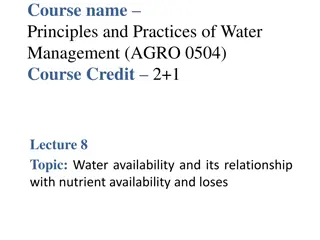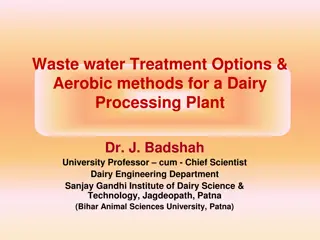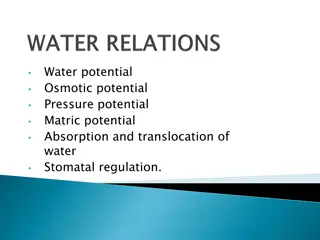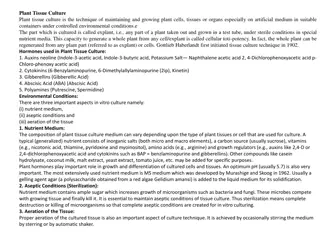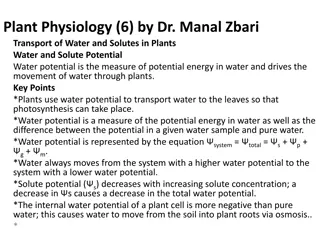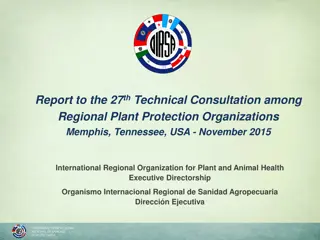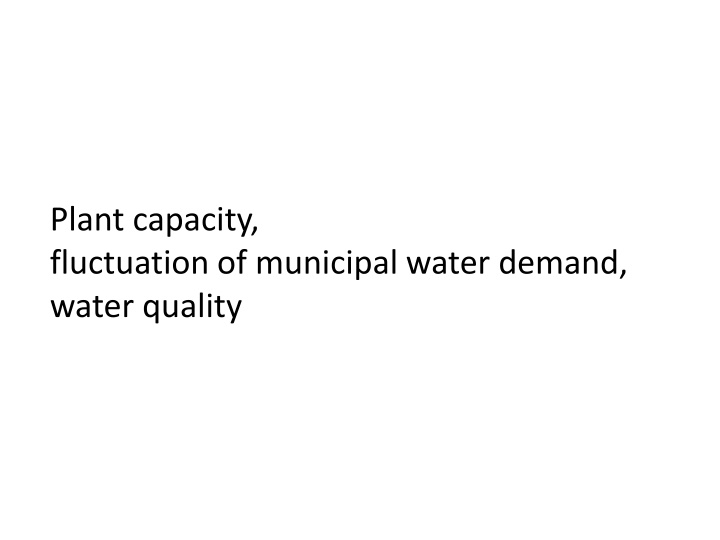
Water Treatment Plant Capacity and Municipal Demand Fluctuation
Explore the vital aspects of water treatment plant capacity planning, including population projections, per capita water demand analysis, and fluctuations in municipal water demands. Understand the factors influencing plant capacity decisions and water quality considerations.
Download Presentation

Please find below an Image/Link to download the presentation.
The content on the website is provided AS IS for your information and personal use only. It may not be sold, licensed, or shared on other websites without obtaining consent from the author. If you encounter any issues during the download, it is possible that the publisher has removed the file from their server.
You are allowed to download the files provided on this website for personal or commercial use, subject to the condition that they are used lawfully. All files are the property of their respective owners.
The content on the website is provided AS IS for your information and personal use only. It may not be sold, licensed, or shared on other websites without obtaining consent from the author.
E N D
Presentation Transcript
Plant capacity, fluctuation of municipal water demand, water quality
Plant capacity The design capacity of the water treatment plant is generally based on the demand that is expected to occur at the design year. This involves forecasting of the demand in the future which depends mainly on population projection and per capita water demand.
Population projection: the most common approach to forecast the plant capacity is based on population projections of the service area to the design year. There are many mathematical and graphical methods that are used to project past population data to the design year, such as arithmetic growth, geometric growth ..etc. In general, the population and rate of growth greatly depend on, birth and death rate, immigration rate, urbanization, commercialization , industrialization.
Per capita water demand: The required amount of water/capita depends on many factors such as climate, economic condition of the community, degree of industrialization, metered water supply, cost of water, water conservation efforts and others. It is customary to express water consumption in litter/ capita.day (LPCD) this figure represents the average daily amount required per person during a period of one year and it generally is estimated by dividing the annual average daily water consumption by the total population served. The per capita demand typically includes all treated water that is used by industrial, public services and system losses. residential, commercial,
Fluctuation of municipal water demand There is a wide variation in seasonal, daily and hourly water demands. Some of the general observations of municipal water demands can be summarized as follows: Working days have higher demand than holidays. Hot and dry days have more demand than wet and cold days. Maximum months are typically July and August (summer).
Within a day, there are two demand peaks, one peak is in the morning as the day activities start, the other peak is at the evening. The average demand represents the average daily demand over one year, it is often referred to as annual average daily demand. The maximum day demand represents amount of water required during the day of the maximum consumption during a year. The maximum demand is particularly sensitive to the weather conditions.
Peak hour demand represents the amount of water required during the maximum consumption hour in a given day. Maximum demand and peak hourly demand are usually expressed as a ratio to the mean average daily flow. These ratios vary greatly for different cities, therefore, a careful study for each city must be done from the past data to develop this fluctuation.
In the absence of water demand data, the following equation is used to estimate the ration of maximum month, week, day and hour demand. ? = 180 ? 0.1 P: percent of the annual average demand for time (t) t: time (day)varies from 2/24 to 365. The average and maximum daily demand is required to analyze the peak capacity of the treatment plant, while peak hour is used to analyze the maximum capacity required of the high service pumps to be able to deliver peak water demand during the peak hour of the day.
Ex: estimate the water requirements for a community that will reach a population of 120 000 at the design year. The estimated water demand for the community is 610 L/c.d. Calculate the flow, design capacity of the water treatment plant and design capacity of the water distribution system. Solution: Average day water demand = (610 L/c.d x 120 000)/(1000 x 24 x 60) = 50.83 m3/min Maximum day demand ? = 180 ? 0.1 (t = 1 for average daily demand)
P = 180 % = 1.8 The maximum day demand = 1.8 x 50.83 = 91.5 m3/min = 131760 m3/day Calculate peak hour demand P = 180 x (2/24)-0.1= 231% = 2.3 (peak hour demand is distributed over two hours) P = 2.31 x 50.83 = 117.3 m3/ min
Water quality constituents Natural water may contain suspended and dissolved inorganic and organic compounds and microorganisms. The inorganic compounds originate from weathering of rocks, solid and sediments. The organic compounds originate from decaying plants and animals matters. Municipal and industrial waste contribute to a wide spectrum of both organic and inorganic impurities.
Inorganic constituents: Including the following principal chemical constituents in addition to trace constituents. Magnesium Calcium Sodium Chloride Potassium Inorganic constituents Floride Iron Manganese Phosphate Sulfate Nitrate Bicarbonate - carbonate
Inorganic water quality indicators Several water quality parameters are used to describe properties of water. Alkalinity: alkalinity in natural water is due to primarily the presence of bicarbonate and carbonate ions. Alkalinity of water varies in concentration with geographical location depending particularly upon the character of the rocks and soils in the area. For healthy fresh water, the desirable bicarbonate alkalinity range is 30 130 mg/L as caco3. the pH is well maintained of 6.5 8.2.
Hardness: hard water is generally associated with formation of scales in boiler, heaters and hot water pipes. Hard water also prevents formation of leather until excessive soap is consumed. Hardness in natural water is due primarily to calcium and magnesium ions. Area that have limestone formations generally have hard water. Total hardness mg/L as caco3 0-40 Classification Soft 40-100 Moderately hard 100-300 Hard 300 500 Very hard Greater than 500 Extremely hard
Hard water have had no harmful effects upon the health of people. Hardness over 100 mg/L in municipal water supplies has been found inconvenient by reason of excessive soap consumption. Recent studies relate soft water to heart disease, simply because the soft water is corrosive and dissolves potentially harmful substances from the piping and plumbing. Total dissolved solids (TDS): total dissolved solids in natural water are due to inorganic salts. In river and lakes, the concentration of TDS in water will vary depend on the time of the year, local geological condition, climate and waste discharge.
The EPA recommends a maximum of 500 mg/LTDS in drinking water supply. Above this level, the water may have a salty test. Conductivity : the electrical conductivity (EC) is related to TDS. It is a measure of the ability of the water to conduct an electrical current. It is reported in micro siemens per centimetre. Because the electrical current is transported by the ions in solution, the conductivity increases as TDS increases.
Dissolved oxygen (DO): In nature clean water is saturated with DO or nearly so. The level of DO in natural water is an indication of pollution. Low DO concentrations are likely to be associated with low quality water. If organic wastes are discharged into the natural water, microorganism decompose these wastes and utilize the DO. Turbidity: turbidity in water is caused by the presence of such suspended matter as clay, finely divided organic and inorganic matter, and microorganisms Turbidity represents the optical property of water which causes light to be scattered and absorbed rather than transmitted.
Attempts to correlate turbidity with suspended solids concentration are impractical because the size and shape of particles are important optically but have little direct relationship to the suspended matter. concentration of the Nephelometers are now the standard instrument for measurement of law turbidities and give results in terms of the Nephelometric turbidity units NTU.
Organic constituents: The organic compounds in natural water are derived from natural decomposition of plants and animals materials. Organic compounds may also reach surface water from municipal and industrial discharge. Organic compounds could be divided to natural organic matters which originates from plant and animal residues and synthetic organic compounds such as surfactant, pesticides, cleaning solvents etc. The concentrations of organic matters in natural water is generally small. The most common measurements include BOD5 ,COD and TOC.
Microorganisms: Bacteria: their importance in water supply is greatly because they may cause disease. Most bacteria are harmless and may are actually beneficial. Some bacteria produce by products that inhibit growth of many pathogens. Other types of bacteria are pathogens Viruses: they are the smallest of infectious agents. Viruses are more resistant to disinfection than bacteria, but in a natural water they are present in far fewer numbers than bacterial pathogens Other microorganisms such as fungi, Algae and Protozoa.
Indicator organisms: Analysis of water for all the known pathogens is very impractical, for that reason, indicator organisms are used. Coliform organisms currently used as indicator organisms, these are non-pathogenic bacteria whose origin is in faecal matter. The presence of these bacteria in water is an indication of faecal contamination and probably unsafe water. The results in reported as most probable number per 100 ml (MPN / 100 ml).
Water treatment plants The principal objective of a water treatment plant is to produce water that satisfies a set of drinking water quality standards to the consumer at a reasonable price. A water treatment plant utilizes many treatment processes to produce water of a desired equality. The most common processes in conventional treatment plants are: screening, sedimentation, filtration, disinfection .etc. coagulation, flocculation,
Other processes that might be used in treatment plants are: aeration, chemical, precipitation, activated carbon absorption, fluoridation, membrane ..etc. Many factors should be considered in determination of the required processes in a certain treatment plant such as: characteristics and seasonal variation In the raw water quality, site condition, Plant economics, required effluent characteristics etc.


